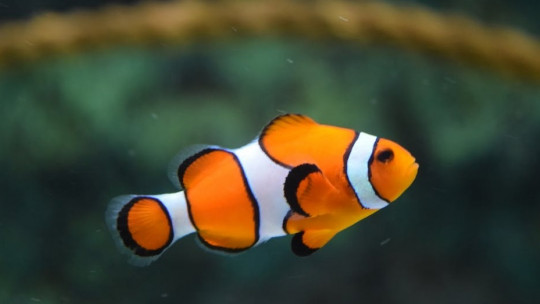
The fear of certain animals is an adaptive and relatively normal fear, as long as it is proportionate and in harmony with the real danger of the animal in question. However, when this fear dominates us and conditions our behavior we can talk about phobias.
One of these phobias related to marine fauna is ichthyophobia In this article we will see what this disorder is about, as well as its causes, symptoms and possible treatments.
What is ichthyophobia?
Ichthyophobia belongs to the group of specific anxiety disorders or specific phobias, in which the person experiences an exacerbated, irrational and uncontrolled fear of fish. This phobia It is included in zoophobias or specific phobias of animals However, it should not be confused with selakophobia, in which the object of fear is based solely on sharks.
In ichthyophobia, the person experiences an exaggerated fear of any fish, regardless of its danger or size. Those who suffer from this condition usually manifest a great repulsion towards everything related to fish including fish as food.
As with most phobias, ichthyophobia can be slightly different in each person who experiences it, due to individual variability in thought patterns associated with fish.
Unlike the animosity that each person may feel when encountering some type of fish in natural circumstances, such as bathing on the beach, in ichthyophobia the person is able to recognize that the animal does not have to represent a threat. . However, despite this, the patient is completely unable to resist the great fear it provokes.
In any case, when the phobic stimulus appears, the person with ichthyophobia will experience a series of emotions and physical manifestations typical of an extremely high state of anxiety
Symptoms of this phobia
Since ichthyophobia is a condition typical of specific anxiety disorders, it shares a large number of symptoms with other specific phobias. This symptomatology includes three large sets of symptoms: physical, cognitive and behavioral.
It is necessary to specify that, although most people experience the same symptoms, both the intensity of ichthyophobia symptoms and their incidence can vary from one person to another.
1. Physical symptoms
The appearance or coincidence of the person with the phobic stimulus, in this case fish, triggers hyperactivity of the autonomic nervous system, which generates an immense amount of changes and alterations in the body. Within these changes we find:
2. Cognitive symptoms
The fear and anxiety reactions reactive to the appearance of the feared stimulus are due to a previous association of this stimulus with irrational ideas and beliefs. These altered ideas of reality stimulate the development of the phobia, and are characterized by the person holding a series of poorly or unfounded thoughts about fish, as well as their attributes and qualities.
These thoughts can be reflected in the following way:
3. Behavioral symptoms
Like any phobia or specific anxiety disorder, ichthyophobia is accompanied by a series of symptoms or behavioral manifestations that originate in response to the appearance of the aversive stimulus
The objective of these behaviors is either to directly avoid the feared situation, or to escape after the appearance of said stimulus or situation. These behaviors are known as escape or avoidance behaviors.
Avoidance behaviors are executed with the intention of avoiding encounters with any type of fish. In them, the person carries out all types of behaviors to avoid the possibility of encountering the stimulus that is the object of the phobia. In this way, the aim is to avoid experiencing feelings of anguish and anxiety that these animals generate.
Some behaviors that serve as an example are those of avoid bathing in rivers, lakes or beaches ; as well as in any context or medium in which any type of fish could appear.
On the other hand, escape behaviors appear when the person has not been able to avoid encountering the phobic stimulus, so they will carry out all types of behaviors that allow them to escape from the current situation as soon and as quickly as possible.
What causes does it have?
Like many other phobias, it is practically impossible to determine with complete accuracy what is the origin or cause of this irrational fear. However, in the same way that ichthyophobia shares symptoms with other anxiety disorders they also share the same base or foundation.
A person with a genetic predisposition, which neurobiologically conditions them to suffer to a greater extent the ravages or psychological effects of stress, and who has also faced at some point in their life a highly traumatic experience or one with a very high emotional burden. , in which the aversive stimulus has played an important role; You will be much more likely to develop any type of phobia.
Both ichthyophobia and any anxiety disorder are usually acquired after the person has had an unpleasant experience with the phobic stimulus or the thought of it. In most cases these phobias are developed during childhood, since children are much more susceptible to any stressful event.
Some events that can trigger this excessive fear of fish They can be attacks, stings or bites while the person was bathing; or after reading certain information about some fish or watching certain movies, documentaries or television programs.
Is there a treatment?
Although in many cases ichthyophobia is not disabling, that is, it does not usually interfere with the patient’s life except on rare occasions, an adequate diagnosis and treatment can reduce, and even eliminate, the stress response associated with the stimulus.
Due to its high effectiveness in these cases, intervention through cognitive-behavioral psychotherapy is the most widely used when treating a phobia. However, there are a large number of interventions and therapies that, performed correctly and always by an expert, can also offer satisfactory results.
This type of treatment combines live exposure techniques or systematic desensitization with training in relaxation and cognitive restructuring techniques, in this way the person can master their phobic fear and carry out all types of activities without fearing the appearance of these animals. .








